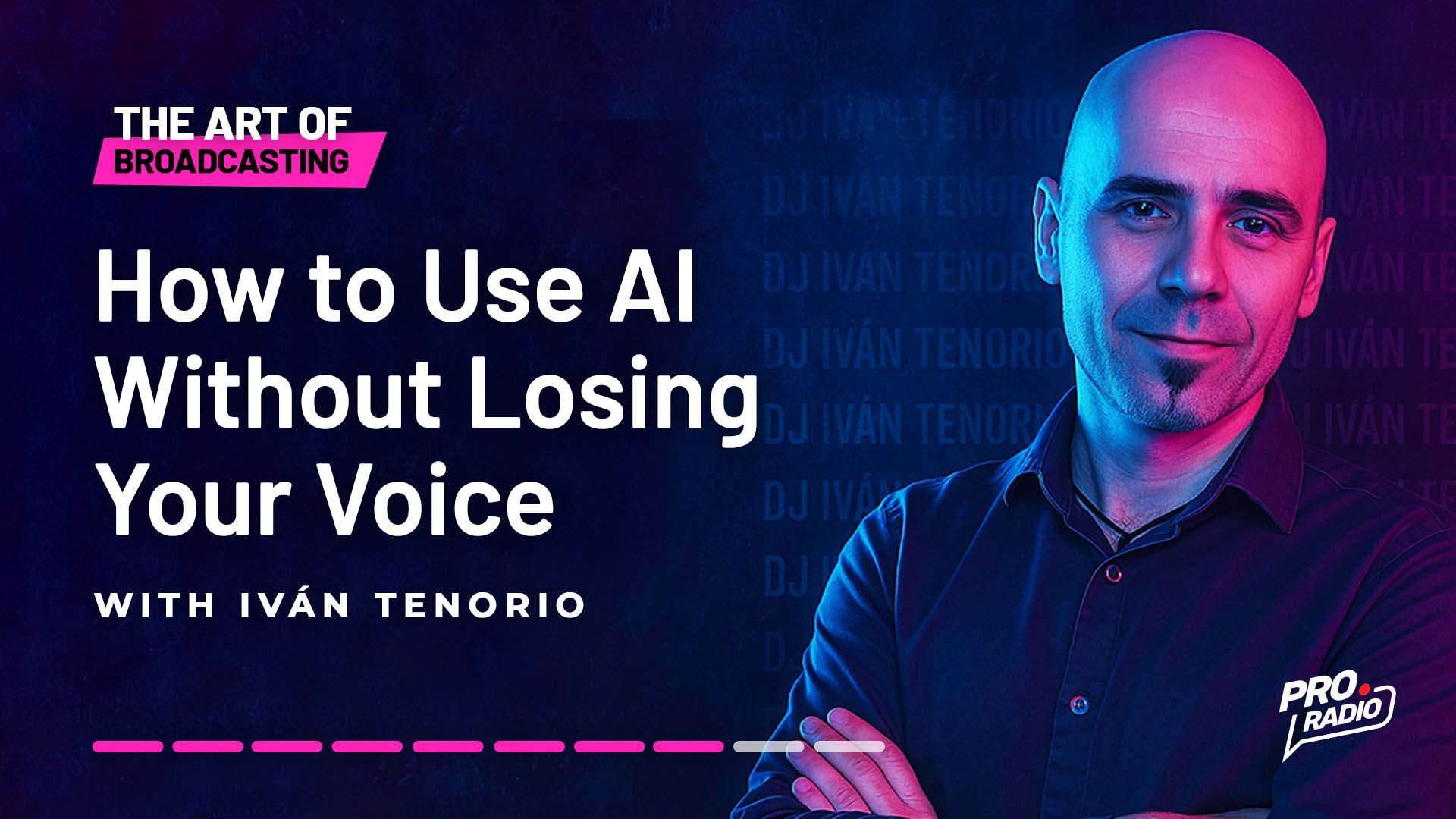- arrow_back Home
- keyboard_arrow_right The Art Of Broadcasting
Chapter 8. How to Use AI Without Losing Your Voice
The Art Of Broadcasting 29 280 Pro Radio WordPress Theme June 18, 2025

Use Artificial Intelligence as a Tool, Not an Excuse
We’re living in a moment where AI is so deeply integrated into the creative space that, if we’re not careful, we might stop creating and start simply accepting whatever the machine suggests. And in radio, that’s a surefire way to lose your direction.
Let’s be clear from the beginning: AI is a tool. A powerful one, yes. Surprising, too. But it should never replace your point of view, your style, or your judgment.
This chapter is all about how to make the most of AI without letting it steal your voice—literally and metaphorically.
VIDEO SNEAK PEEK:
What Can AI Do for a Radio Station?
-
- Speed: Quickly drafts texts, scripts, intros, or closings.
- Versatility: Can write in different tones, for various audiences or formats.
- Consistency: Helps maintain a coherent editorial line.
- Assistance: Corrects mistakes, rephrases ideas, suggests creative angles.
But don’t be fooled—letting AI do everything is the easy way out. The bold (and professional) path is using AI as an extension of your thinking, not as a content vending machine.
✍️ Authorship: Non-Negotiable
You’re the one who connects with your audience. You set the pace, the tone, the angle.
That’s why anything generated by AI must go through a human filter—yours.
Think of AI like a junior copywriter with lots of knowledge but no intuition. It can help you write, but it can’t live your experiences, understand your neighborhood’s nuances, or anticipate what your listener needs today.
Your job isn’t to compete with AI—it’s to make it work for you.
That’ll make you more effective, faster, and freer to focus on what truly matters: meaningful content.
⚙️ Where to Use AI Without Losing Your Essence
- Structuring your scripts, rundowns, or segments.
- Summarizing large blocks of content that you’ll later adapt.
- Generating initial ideas or reworking large texts.
- Automating repetitive tasks: descriptions, metadata, headlines.
The key: you provide the first input (a clear idea) and the final touch. AI suggests—you decide.
Practical Exercise
Today you’ll create a short 2-minute radio block (around 260 words), using AI to streamline the process.
- Think of a topic you want to communicate (e.g., a musical anniversary, a local curiosity, a personal reflection).
- Open your AI tool of choice (like ChatGPT) and use this prompt:“Write a short script to be read on an online radio station. The tone should be casual, conversational, addressed to a single listener. It must sound natural, with short sentences, an oral rhythm, and no jargon. The topic is: [your topic here].”
- Read the result out loud.
- Edit anything that doesn’t sound like you. Add pauses, change expressions, shorten phrases.
- Record it. Listen back. Does it sound like you?
If by the end it sounds like you—and not like a machine—you’ve done it right.
AI Hack: Make AI Write Like You
Create your own “digital self”:
- Choose 3 texts you’ve written (scripts, posts, older articles).
- Give them to the AI with this instruction:“These are texts I’ve written. Learn my style, tone, and way of communicating. From now on, write following this model. Be direct, clear, with an oral rhythm and a radio-friendly structure.”
This helps you maintain consistency and save time without sacrificing identity.
Tip: Don’t be afraid to correct the AI. The more feedback you give, the better it understands you.
Tools to Sound Like You—with AI Help
AI shouldn’t replace you, it should amplify you. But you need to know the right tools—and how each can support your workflow without erasing your style.
Here’s a list of real-world AI applications for online radio. They save time, boost quality, expand creativity… and most importantly: preserve your voice.
You don’t need them all. But knowing your options lets you choose what fits your workflow best.
Remember: the magic isn’t in the technology—it’s in how you use it.
25 Ways to Use AI in Your Radio Station (with Tools)
VOICE AND BROADCASTING
- Create synthetic voices for promos or shows
Tool: ElevenLabs
Use: Continuity, narration, characters, automated bulletins. - Auto-dubbing in other languages
Tools: ElevenLabs, HeyGen
Ideal for: multilingual formats or global audiences. - Generate radio-style voiceover texts
Tool: ChatGPT + custom prompts
Use: intros, closings, music contexts, transitions. - Refine scripts for natural, spoken rhythm
Tools: Grammarly, ChatGPT
Helps with tone, flow, and conversational clarity.
SCRIPTS AND PROGRAMMING
- Automated writing of daily segments and cultural tidbits
Tools: ChatGPT, Perplexity
Ready-to-air content in seconds. - Create thematic rundowns and music programming
Tools: ChatGPT + ClockWheel
Perfect for segmented radio formats. - Idea assistant for new segments
Tools: GPT + SCAMPER + mind mapping
Add variety while staying on-brand. - Auto-summary of interviews for post-production
Tools: Whisper (OpenAI), Descript
Great for “best of” clips or highlights.
AUDIO AND EDITING
- Automatic audio enhancement (voice or music)
Tools: Auphonic, Adobe Podcast Enhance
Volume leveling, noise cleanup, EQ. - Synthesize sound effects or environments
Tools: Mubert, Soundraw
Great for soundscapes, intros, promos. - Text-to-speech with natural intonation
Tools: Murf, PlayHT, ElevenLabs
Perfect for news updates or current affairs.
SMART PRODUCTION
- Select music by mood
Tools: Mubert AI, Boomy, Aiva
Automates playlist curation by emotion. - Auto-detect technical issues (volume, silence)
Tools: Audacity with plugins, Descript
Better sound quality with less effort. - Vocal quality check: detect peaks and noise
Tools: Izotope RX, TDR Kotelnikov
Cleaner, more consistent broadcasts.
ANALYSIS AND IMPROVEMENT
- Analyze broadcast content (topics, tone, length)
Tools: Whisper + GPT + spreadsheets
Learn what works and fine-tune your grid. - Automatic transcription for your website
Tools: Whisper, Sonix, Descript
Boost SEO, accessibility, and archives. - Auto-classify music genres
Tools: MusiCNN, AudioSet with trained AI
Reorganize your music library efficiently.
MARKETING AND DISTRIBUTION
- Write social media posts
Tools: ChatGPT, Canva Magic Write
Expand your online presence effortlessly. - Auto-generate catchy headlines
Tools: Jasper AI, ChatGPT
For newsletters, homepages, or clips. - Create voice-driven promo campaigns
Tools: ElevenLabs + ChatGPT
Customizable by audience or region.
MANAGEMENT AND PERSONALIZATION
- Custom programming assistant
Tools: Custom GPTs (Plus version)
Plan shows by key dates or events. - Generate tags, metadata, and descriptions
Tools: ChatGPT + Rephonic
Improve podcast and broadcast SEO. - Create presenter avatars for online interaction
Tools: Synthesia, HeyGen
Integrate voice + image on socials or apps. - Personalize newsletters by listener interest
Tools: ChatGPT + listening data
Smarter content segmentation. - Use AI to simulate focus group reactions
Tools: ChatGPT + listener personas
Test segments before going live.
Final Thought
“Using AI isn’t giving up. It’s collaboration.
But never delegate what makes you unique: your voice, your judgment, your point of view.”
This series gives you all the tools to sound professional. And that includes knowing when to delegate… and when not to.
Because if your radio sounds like just anyone, it’s not really you. And if it’s not you—it won’t move people.
Ready to sound like yourself, with a little machine help?
Let’s go. The mic is waiting. GO!
You may also like
Copyright 2019-2025 ProRadio© Qantum Themes SL©









